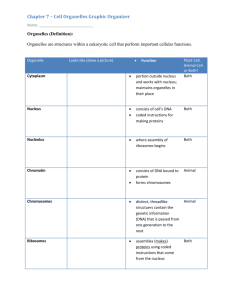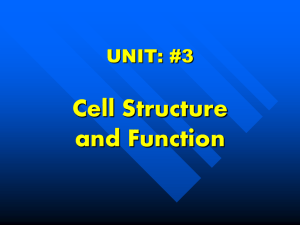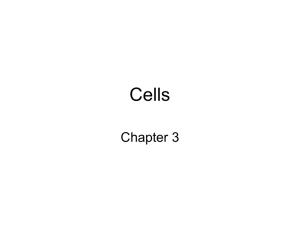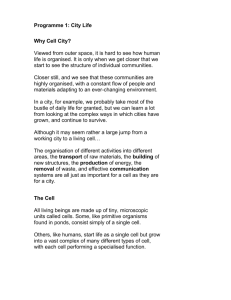Chapter 7 Cells – Notes
advertisement
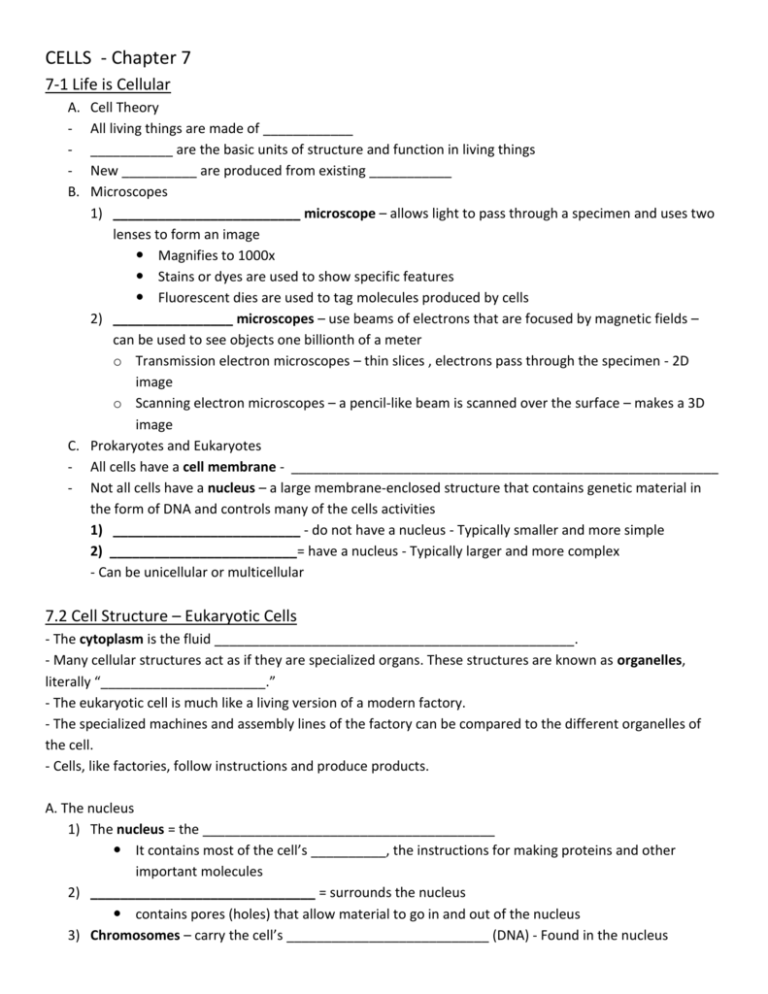
CELLS - Chapter 7 7-1 Life is Cellular A. B. Cell Theory All living things are made of ____________ ___________ are the basic units of structure and function in living things New __________ are produced from existing ___________ Microscopes 1) _________________________ microscope – allows light to pass through a specimen and uses two lenses to form an image Magnifies to 1000x Stains or dyes are used to show specific features Fluorescent dies are used to tag molecules produced by cells 2) ________________ microscopes – use beams of electrons that are focused by magnetic fields – can be used to see objects one billionth of a meter o Transmission electron microscopes – thin slices , electrons pass through the specimen - 2D image o Scanning electron microscopes – a pencil-like beam is scanned over the surface – makes a 3D image C. Prokaryotes and Eukaryotes - All cells have a cell membrane - _________________________________________________________ - Not all cells have a nucleus – a large membrane-enclosed structure that contains genetic material in the form of DNA and controls many of the cells activities 1) _________________________ - do not have a nucleus - Typically smaller and more simple 2) _________________________= have a nucleus - Typically larger and more complex - Can be unicellular or multicellular 7.2 Cell Structure – Eukaryotic Cells - The cytoplasm is the fluid ________________________________________________. - Many cellular structures act as if they are specialized organs. These structures are known as organelles, literally “______________________.” - The eukaryotic cell is much like a living version of a modern factory. - The specialized machines and assembly lines of the factory can be compared to the different organelles of the cell. - Cells, like factories, follow instructions and produce products. A. The nucleus 1) The nucleus = the _______________________________________ It contains most of the cell’s __________, the instructions for making proteins and other important molecules 2) ______________________________ = surrounds the nucleus contains pores (holes) that allow material to go in and out of the nucleus 3) Chromosomes – carry the cell’s ___________________________ (DNA) - Found in the nucleus 4) ________________________– a small dense region in the nucleus ___________________ are assembled here B. Organelles that store, clean up, and support 1) Vacuoles –large saclike _____________________________________ - Store water, salt, proteins, and carbohydrates - In plants there is often 1 vacuole filled with liquid - Also found in unicellular organisms and animals for storing and moving materials 2) _________________________ – small organelles filled with enzymes - Break down lipids (fats) , carbohydrates, and proteins - Help break down _______________________ - removes “_______________” from the cell - Found in animal cells and some plant cells 3) ___________________ – a network of protein filaments that give cells shape and internal organization - Helps maintain cell shape and involved in movement 4) Microfilaments – form a framework that supports the cell and help them move 5) Microtubules – hollow structures made of proteins called tubulins - are involved in maintaining cell shape and in cell division - Also form cilia and flagella 6) Centrioles – located near the nucleus and _________________________ in animals (made of tubulins) C. Organelles that build protein 1) ______________________ – the “___________________________” - where proteins are assembled - small particles of RNA and protein found throughout the cytoplasm in all cells. - produce proteins by following coded instructions that come from DNA. - Each ribosome is like a small machine in a factory, turning out proteins on orders that come from its DNA “boss.” 2) Endoplasmic reticulum (________) – an internal membrane system where lipids are assembled and proteins and other materials are exported from the cell. 3) _________________ endoplasmic reticulum (rough ER) – the ER where __________________ occurs - ________________________ on its surface - Proteins made in the rough ER can be exported out of the cell or transported to other places in the cell 4) _________________ endoplasmic reticulum (smooth ER) – the ER where no ribosomes are found - Contains enzymes to do tasks like making ______________________ or detoxification of drugs 5) Golgi Apparatus - ______________________________ proteins and other materials from the ER for storage in the cell or transport out of the cell. - Looks like a stack of flattened membranes - “_________________” proteins to their final destination D. Organelles that capture and release energy 1) Chloroplasts – capture the _________________________ and convert it into food (photosynthesis) - Found in _______________ and some other organisms - “______________________________________” 2) - Mitochondria – “_____________________________” convert the chemical energy stored in food into compounds easier for the cell to use In humans, you inherit most of your mitochondria from your ______________ Contain small DNA molecules which suggest they may have been descended from independent microorganisms. E. Cellular Boundaries 1) Cell Wall – ________________________________________________________ - Allow water, oxygen, carbon dioxide to pass through - Found in prokaryotes and eukaryotes (NOT ANIMALS) - Provides ______________________ in plants (wood is made of mostly cell walls) 2) Cell Membrane – controls what ______________________________________ and supports - Made of a _________________________ (see the next slide) - The cell membrane is made of a double layered sheet with lipids and proteins - The cell membrane is ___________________ – some substances are allowed to pass and some are not. PLANT VS ANIMAL CELLS pg 206 7.3 Cell Transport A. Passive Transport = The movement of materials across the cell membrane without using cellular energy 1) Diffusion - The process by which _________________ from an area of _______________________ to an area of _________________________________ 2) ________________________Diffusion – the process where molecules that cannot directly diffuse across the membrane pass through special ___________________________ 3) Osmosis –the ________________________ through a ___________________________ membrane - Water moves across a membrane until equilibrium is reached Types of Solutions Isotonic = When the concentration is the ___________ on both sides of the membrane ____________________ = The more concentrated solution ___________________ = The dilute solution Osmotic pressure = the net movement of water out of or into a cell exerts a force B. Active transport = movement of materials _________________________ difference (requires ___________ Movement of large molecules


